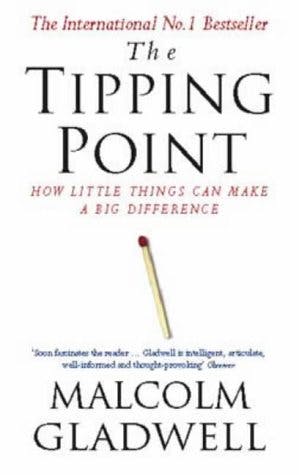One of the things I enjoy about HR is that you can take many lessons from other functional areas of the business.
One of the most interesting areas to me is marketing and specifically, how new or changed ideas and concepts take root and thrive. It’s not obvious since many good ideas fail to take hold regularly. It fascinates me because people are generally so fickle and no one has really figured out a formulaic way to bring great ideas to market.
When we think about instituting some sort of organizational change, we should think of it like we are trying to sell something important to our customers: the employee. While it may not be the most simple thing to do, we can really impact the effectiveness of a change.
Your Tipping Point
I really enjoy Malcolm Gladwell‘s books and articles, and The Tipping Point is an excellent read. If I had to sum up the point of the book, it is the idea that change spreads like a virus and (maybe more importantly) some people are better at spreading new ideas than others. If you look at the ways that movies, music, art and fashion all become popular, you can look at the idea that at a certain point, a large portion of the population was convinced that they had to get that too.
Subsequently, we can also see the failures of ideas that may have been just as good (if not better) but were never put in the right people’s hands. They never bought into the idea. So you have very good records that never got air play or weren’t commercially viable simply because not enough thought was given to how to really market them.
It isn’t perfect of course. Fast Company had a great piece as to why simple mass marketing may still be a better use of advertising dollars. But to me at least, it helps explain the seemingly odd way that things in pop culture become popular. Once you hit an influencer group and enough people buy in, the idea hits its “Tipping Point.”
How does this apply to organizations?
In every organization, there is a formal leadership structure, and when changes are made, it uses this structure to disseminate any changes. This is fairly easy and uses the chain of command in place to make things happen. It’s also not a big deal when the changes are more minutia than important ones.
But when it comes to bigger decisions, thinking about ways to include informal leaders and influencers in your organization is key to getting buy-in across the entire company. And that doesn’t mean simply telling them first, either. It means including them in the decision-making process and putting concerns to rest early. And there are a couple of issues that come up with them, including dealing with informal leaders.
For one thing, designated leaders who hold positions higher in the org chart are going to object to giving equivalent weight to the opinions of an informal leader or influencer. This isn’t something that is easily overcome either, since leaders in a formal structure often discount the idea of influencers all together and want to stick with the formal structure.
Identifying Influencers
The other issue is identifying these people in your organization. Because people may not realize why they are taking specific actions or asking certain people to be involved, it does very little good to ask.
After the first time I read The Tipping Point, I started trying to figure out who was an informal leader that was capable of making or breaking an initiative in our company. I found one person in our organization who was critical to the success of most of our initiatives. How did I figure it out?
- I observed who was invited to critical meetings. He was only a business unit manager but he was often invited into meetings with the President and VP’s. The formal leadership knew that he was critical to their initiatives but didn’t know why. It seemed like second nature that he should be involved even though other business unit managers weren’t included.
- I sat in on meetings this business unit manager held with his subordinates. If he liked an idea, he was able to get his subordinates to buy into it and sell it to their subordinates.
- I also sat in on meetings among all business unit managers and quickly figured out he was the sounding board to their ideas. If he liked something, others would buy into it and if he didn’t, they would work on fixing it until it worked.
- His team of subordinates were also the ones most involved in cross-functional teams. That means they talked (informally) about what was going on. If the change was going well in his area, it was a good bet that the rest of the company knew that as well.
So it was a combination of many different factors, none obvious in themselves, but together they painted a picture about how the person’s position in the formal structure (and the respect his colleagues had for him) made him critical to our decisions. Before I went too far with any new idea, I would run it by him early and when I would talk to others in the organization, I would strategically name-drop him and his approval.
Employing a similar strategy as you’re looking to make organizational change will help improve the chances of success. At the very least, it couldn’t hurt. And that’s a good thing when you’re gambling on a change initiative being successful.
